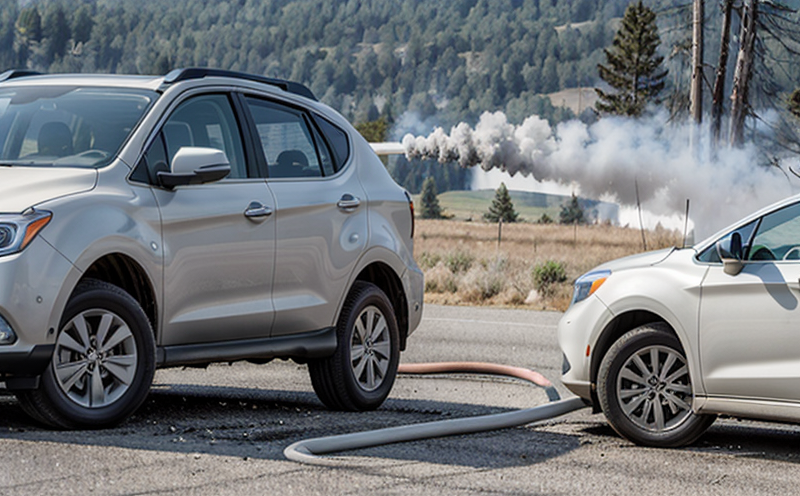Flue Gas Analysis in Reaction-to-Fire Testing
In fire safety testing, particularly within the realm of smoke density and toxic gas emission analysis, flue gas analysis during reaction-to-fire (RTF) tests is a critical procedure. This process involves collecting and analyzing gases emitted from materials or systems when exposed to fire. The goal is to understand how these materials respond under real-world fire conditions, providing essential data for product development, compliance, and safety.
The flue gas analysis itself encompasses the measurement of various parameters such as carbon monoxide (CO), carbon dioxide (CO2), hydrogen chloride (HCl), nitrogen oxides (NOx), and other potentially hazardous compounds. These analyses are conducted using advanced instrumentation like gas chromatographs, infrared spectrometers, and mass spectrometers.
During RTF tests, specimens are exposed to controlled fire conditions, and flue gases are collected from the combustion chamber for analysis. The data derived provides insights into the combustion behavior of materials, helping manufacturers design products that meet stringent safety standards. This information is crucial not only for ensuring compliance with international regulations but also for enhancing product performance and user safety.
The accuracy and reliability of flue gas analysis are paramount in fire safety testing. It allows stakeholders to evaluate the effectiveness of fire-resistant materials and systems, assess potential risks, and make informed decisions regarding product improvements. The results can influence design modifications, material selection, and even market positioning based on the safety and performance attributes.
It is important to note that the methodologies used in flue gas analysis adhere to international standards such as ISO 56601-2 for smoke density testing and ASTM E907 for toxic gas emission tests. These guidelines ensure consistency and comparability of results across different laboratories and regions.
Specimen Preparation
The preparation of specimens involves ensuring that the material or system to be tested is representative of real-world conditions. This includes testing a variety of materials such as building products, furniture, textiles, and electrical components. The specimens are typically cut into standard sizes and shapes to allow for consistent exposure to fire.
- Standard dimensions: Specimens are prepared to ISO 13984-2 or ASTM E725 specifications to ensure uniformity.
- Surface cleaning: The specimens are cleaned of any contaminants that could affect the test results.
- Marking: Unique identifiers are applied to each specimen for traceability during testing and analysis.
The fire exposure conditions in RTF tests follow specific protocols defined by relevant standards. These include controlled temperature, oxygen concentration, and duration of exposure. The goal is to simulate real-world fire scenarios that the materials or systems are likely to encounter.
Why It Matters
The importance of flue gas analysis in reaction-to-fire testing cannot be overstated, as it directly impacts product safety and compliance. By understanding how materials behave under fire conditions, manufacturers can develop safer products that meet stringent international standards.
- Enhanced Safety: Flue gas analysis helps identify potential hazards such as toxic gases or excessive smoke production, which are critical for public health and safety.
- Compliance Assurance: Adherence to international standards ensures that products meet regulatory requirements in various markets around the world.
- Product Improvement: Insights gained from flue gas analysis can guide manufacturers in refining their designs, selecting safer materials, and enhancing overall product performance.
The results of these tests are often used to inform decisions about material selection, design modifications, and even market positioning. For compliance officers, the data provides a clear path for ensuring that products meet necessary safety requirements. For R&D engineers, it offers valuable information on how materials can be improved.
International Acceptance and Recognition
- ISO Standards: Flue gas analysis in RTF testing is governed by international standards such as ISO 56601-2 for smoke density testing, which ensures that the methodology is consistent across different laboratories.
- ASTM Standards: The American Society for Testing and Materials (ASTM) provides additional guidelines like ASTM E907 for toxic gas emission tests. These standards are widely accepted in North America and globally.
The acceptance of these tests is crucial as they provide a standardized approach to evaluating fire safety performance, ensuring that the results are reliable and comparable across different regions. This standardization helps manufacturers and regulators alike to have confidence in the test outcomes, facilitating international trade and compliance.
Competitive Advantage and Market Impact
- Innovation Leadership: By investing in flue gas analysis technology and methodologies, organizations can stay ahead of the curve in fire safety testing. This allows them to introduce innovative products that meet or exceed current standards.
- Improved Brand Reputation: Demonstrating a commitment to product safety through robust testing procedures enhances brand reputation among consumers and industry partners.
The ability to provide accurate and reliable flue gas analysis can significantly impact market positioning. Organizations that excel in this area are more likely to gain competitive advantage, as they can offer products that are not only safe but also compliant with the latest international standards. This can lead to increased market share and better customer satisfaction.





